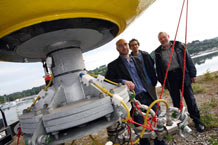
Dr Lars Johanning (University of Exeter), Dave Parish (University of Exeter) and Julian Wolfram with the SWMTF buoy. Photo by Simon Burt, Apex.
Launch powers wave energy research
The ambition for Cornwall to become a world leading centre for wave energy has moved a step closer to reality with the launch of a two tonne (2000kg) buoy off the coast of Falmouth.
Developed by a team at the University of Exeter, the South Western Mooring Test Facility (SWMTF) buoy is a world first.
It will gather detailed information to help inform the future design and development of moorings for marine energy devices.
It will complement the South West RDA’s (Regional Development Agency) Wave Hub project, which will create the world’s largest wave energy farm off the north coast of Cornwall. It also supports wider ambitions to make the South West a global centre of excellence for marine renewables.
The SWMTF is the latest development from PRIMaRE (the Peninsula Research Institute for Marine Renewable Energy), a joint £15 million institute for research into harnessing the energy from the sea bringing together the technology and marine expertise of the Universities of Exeter and Plymouth.
Led by Dr Lars Johanning, the PRIMaRE mooring research group at the University of Exeter successfully developed the £305,000 SWMTF with capital investment from the ERDF Convergence programme matched with funds from the South West RDA. The research team is part of the University of Exeter’s Camborne School of Mines, based on the Cornwall Campus.
The SWMTF buoy has been designed with unique features so it can obtain very detailed data in actual sea conditions to show how moored structures respond to changes in wind, wave, current and tide. Using this information, developers will be able to model and test mooring designs and components for their marine energy devices as they convert wave movement into energy. The SWMTF will also provide data for a wide range of other marine devices.
The SWMTF buoy has a simple, circular design, with specialised sensors and other instruments built into its structure, enabling it to record data to a high degree of accuracy and allow real time data communication to shore. It has taken a year to develop the buoy and its instruments. Most of the components were manufactured by companies in the South West, many of which are in Cornwall.
Dr Lars Johanning of the University of Exeter said: “This is a major milestone in PRIMaRE’s research and we are excited about the potential this might have for the development of the Wave Hub project. It has been a huge challenge to build something that can function in the unpredictable environment of the open sea. This would not have been achieved without the design effort provided by the PRIMaRE project engineers Dave Parish and Thomas Clifford, and the many companies who have risen to the challenge to manufacture the buoy and its instruments. We look forward to announcing the results of our tests after the first set of sea trials.”
Nick Harrington, head of marine energy at the South West RDA, said: “We are investing £7.3 million in PRIMaRE to create a world-class marine renewables research base as part of our drive towards a low-carbon economy in the South West, and this buoy will help technology developers design safe but cost-effective moorings. Our groundbreaking Wave Hub project which is on course for construction next year will further cement our region’s reputation for being at the cutting edge of renewable energy development.”
Carleen Kelemen, Director of the Convergence Partnership Office for Cornwall and the Isles of Scilly, said: “We all face the momentous challenge of global climate change. Together with the immediate carbon and cost savings for us all in energy efficiency, the development of renewables and new low carbon technologies and business solutions are vital if we are to make the most of new and emerging market opportunities that climate change brings.
“This exciting project in helping establish key baseline data in a very challenging marine environment – with ERDF Convergence backing – is a vital step in building the economic capability of Cornwall to be one of the places to do low-carbon business."
Now that the buoy has been launched, the team will conduct the first tests, within the secure location of Falmouth Harbour. The buoy will then be moved to its mooring position in Falmouth Bay. Once moored at this location, data will be transmitted in real time to a shore station for analysis. A surveillance camera will transmit images to the PRIMaRE web page, allowing the team to continually monitor activities around the buoy.
The SWMTF buoy also has the potential to support other offshore industries, including oil and gas or floating wind installations, in the design of mooring systems. Discussions are already underway with instrumentation developers to develop specific underwater communication systems. In addition the development of the SWMTF buoy has helped secure funding for a collaborative European FP7-CORES (Components for Ocean Renewable Energy Systems) programme, taking the University of Exeter to the forefront of European wave energy converter research.
PRIMaRE will also play a strategic role in the Environmental and Sustainable Institute (ESI), which the University of Exeter aims to develop at the Cornwall Campus.
Date: 23 June 2009
